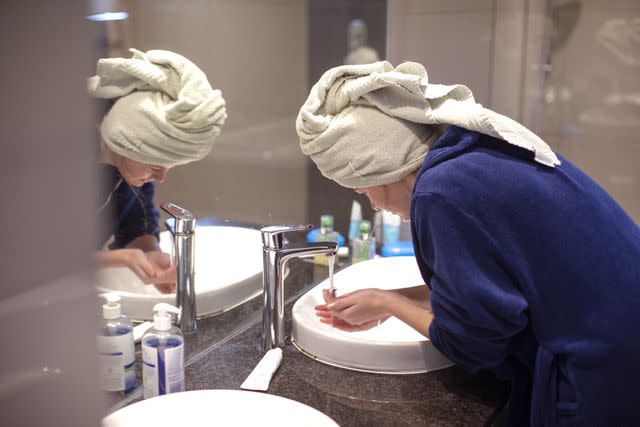Chronic Acne Keloidalis Nuchae: How to Manage It Long Term
Medically reviewed by Susan Bard, MD
Chronic acne keloidalis nuchae (AKN) is a condition in which the hair follicles on the scalp and/or neck are chronically inflamed. Hair follicles are the skin openings out of which hair grows. Chronic inflammation eventually weakens the follicles and can result in ingrown hairs, which burrow into the skin and lead to bumps.
These bumps look like pimples along the hairline on the back of the neck and can become infected. Treatments are available for managing symptoms and for reducing triggers of AKN.
This article discusses the treatment methods available for managing symptoms of AKN and preventing infection. It will also cover possible causes and triggers of AKN, signs and symptoms of infection, and what to do if you have an infection associated with AKN on your scalp and/or neck.

Petri Oeschger / Getty Images
Related: Acne
Treatment: Managing Acne Keloidalis Nuchae
Treatment for AKN comes down to managing symptoms caused by inflammation and preventing them from worsening or leading to scarring or infection. There are several approaches to treating AKN, including learning more about what is triggering or causing your AKN and then addressing those causes directly.
Takeaway
Your healthcare provider will do a physical examination to determine mild grade symptoms vs. severe or advanced AKN. They will look at the size of the affected area, bump size and number, and check for signs of scarring, hair loss, and skin infection.
The American Academy of Dermatology Association (AAD) says treatment plans for managing AKN symptoms may include:
Using an antimicrobial wash like a gentle, foaming benzoyl peroxide wash will help prevent infection associated with AKN
Applying a medicated product containing alpha-hydroxy acid or a retinoid to help soften coarse hairs
Getting corticosteroid cream to apply directly to the area or corticosteroid injection to reduce bump quantity and severity
Taking an antibiotic if necessary to treat existing infection
Draining and treating the larger, swollen, painful bump filled with pus or draining a skin tunnel called a sinus tract
Having a surgical excision or removal of scar tissue caused by keloid-like scarring
Takeaway
A combination of prescribed topicals and shaving changes that help avoid or reduce irritation in two study participants with alopecia or hair loss and AKN. Topical benzoyl peroxide 2.5% and adapalene 1% were prescribed.
Many of the treatments can take months and recurrences are common.
Treatment for AKN doesn’t always result in zero signs and symptoms. In these cases, you should know your dermatologist may recommend other treatment options including laser therapy, phytotherapy or light therapy, and laser hair removal to reduce keloid-like growths or bumps.
In severe cases of advanced AKN, in which there are large areas of scarred skin on the scalp and neck, standard treatment protocols may not work or may not work long term. If all other options have failed and your case of AKN is advanced, your dermatologist may discuss the option of low-dose radiation to kill the hair follicles.
Related: Oral Acne Medication Options
Triggers and Possible Causes
AKN mainly develops in young men between the ages of 14 and 25. It is more prevalent in males than females, particularly men with coarse, stiff, or curly hair.
The AAD says more research is needed to understand how certain hormones more common in males contribute to AKN risk. Possible triggers and causes include:
Frequent close-shave haircuts
Other skin injury (irritation, friction) to the area
Wearing anything on your head
Wearing jewelry around the neck or collared shirt
If the neck and scalp rub due to obesity condition
Obesity (if scalp and neck skinfold and rub)
Having long-term infection
Taking certain medications including medications to treat epilepsy
Having a blood family history of AKN
AKN is not contagious and cannot be "caught" from unsanitary hair clippers, razors, or scissors.
Related: What Causes Acne?
Hair and Neck Hygiene With Acne Keloidalis Nuchae
Hair and neck hygiene are additionally important when someone has AKN to prevent symptoms from worsening and to help maintain any treatment. Your healthcare provider or dermatologist will discuss hair and neck hygiene with you. The AAD says keeping AKN stable is possible with the following methods:
Wash the back of their neck and scalp with a gentle cleanser that contains benzoyl peroxide.
Apply medications as directed.
Symptoms of Acne Keloidalis Nuchae Infection
Skin infection symptoms include:
Localized redness
Warmth or heat coming from the area
Swelling of the affected area
Pus leaking from the affected area
Bleeding from the bumps
AKN infection can, in some cases, also lead to pustules and abscesses.
There are other causes of neck lumps to consider including back of neck cystic acne, boils, muscle knots, lipomas or painless growths under the skin, or in some cases, reactions to soaps and shampoos and detergents. Lumps left untreated can progress to sepsis or bacterial infection or growth and spread (metastasis) of cancer.
Related: Skin Cancer
Treating Infection
If you suspect you have symptoms of infection, consult with your dermatologist about treatment options, including antibiotic medications and more invasive options if necessary such as lump or abscess draining.
Read Next: How to Choose an OTC Acne Treatment Product
Summary
Acne keloidalis nuchae is a chronic condition caused by inflamed hair follicles along the hairline (neck and scalp). Treatment is geared toward managing symptoms and reducing risk of skin infection. It involves medications to treat symptoms or soften coarse hair, switching soaps and face cleansers, and treating infections. Other modalities include light or laser therapy, low-dose radiation, or a surgical procedure to drain pus or remove scarring.
Signs and symptoms of infection include redness, heat, swelling, pus, bleeding, and pain or tenderness. Consult with your healthcare provider or dermatologist for antibiotic treatment.
Read the original article on Verywell Health.

